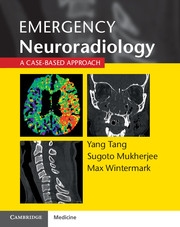Foreword by Mauricio Castillo
Published online by Cambridge University Press: 05 August 2015
Summary
To whom does Emergency Radiology belong? Radiology specialists, radiology generalists, emergency physicians? The truth is that it probably “belongs” to all, depending on where one works. At most teaching hospitals, trainees initially interpret all studies, which are later reviewed by specialists, while at other hospital generalists (sometimes called night hawks) do it all, and at even smaller community hospitals the emergency room personnel may be in charge of rendering the initial imaging interpretations for acutely sick patients. Regardless of who does the initial interpretation of these studies, our knowledge about how to interpret them should come from the best and most experienced specialists, and that is where this case-based book by Drs. Tang, Mukherjee, and Wintermark makes its mark.
Why another case-based book? The way we teach and learn has drastically changed in the last 15 years. While most radiologists of my generation learned by reading (prose) books, younger individuals no longer do it this way. Millennials and Generation Z obtain and process knowledge differently, that is, their knowledge is no longer built in blocks but in a pyramidal fashion by laying a foundation and then building on top of it via the process of accumulating small information bites, synthesizing them, coordinating them, and ending with a good rounded fund of knowledge (or a tall pyramid!). While I learned mostly from text and imagination, newer generations learn mostly in a pictorial fashion, which is perhaps easier and more lasting. This new book does the latter.
Emergency Neuroradiology: A Case-Based Approach is the title of the book you have in your hands – and its name implies expert knowledge, easily delivered and digestible. Beautiful images are accompanied by pithy text and to-the-point information. Cases are grouped into large and general sections, making them easy to find in a hurry. Beyond the usual emergent situations, some cases such as “sinus pericranii” may be useful when facing this entity as an incidental finding in the ED (such as a patient presenting with a bump on the head). CT abounds but MRI, which is increasingly used in emergencies, is also amply represented. We neuroradiologists know that often head emergencies are accompanied by neck and spine ones. Thus, very complete sections on head & neck and spine emergencies are also included.
- Type
- Chapter
- Information
- Emergency NeuroradiologyA Case-Based Approach, pp. xi - xiiPublisher: Cambridge University PressPrint publication year: 2015



